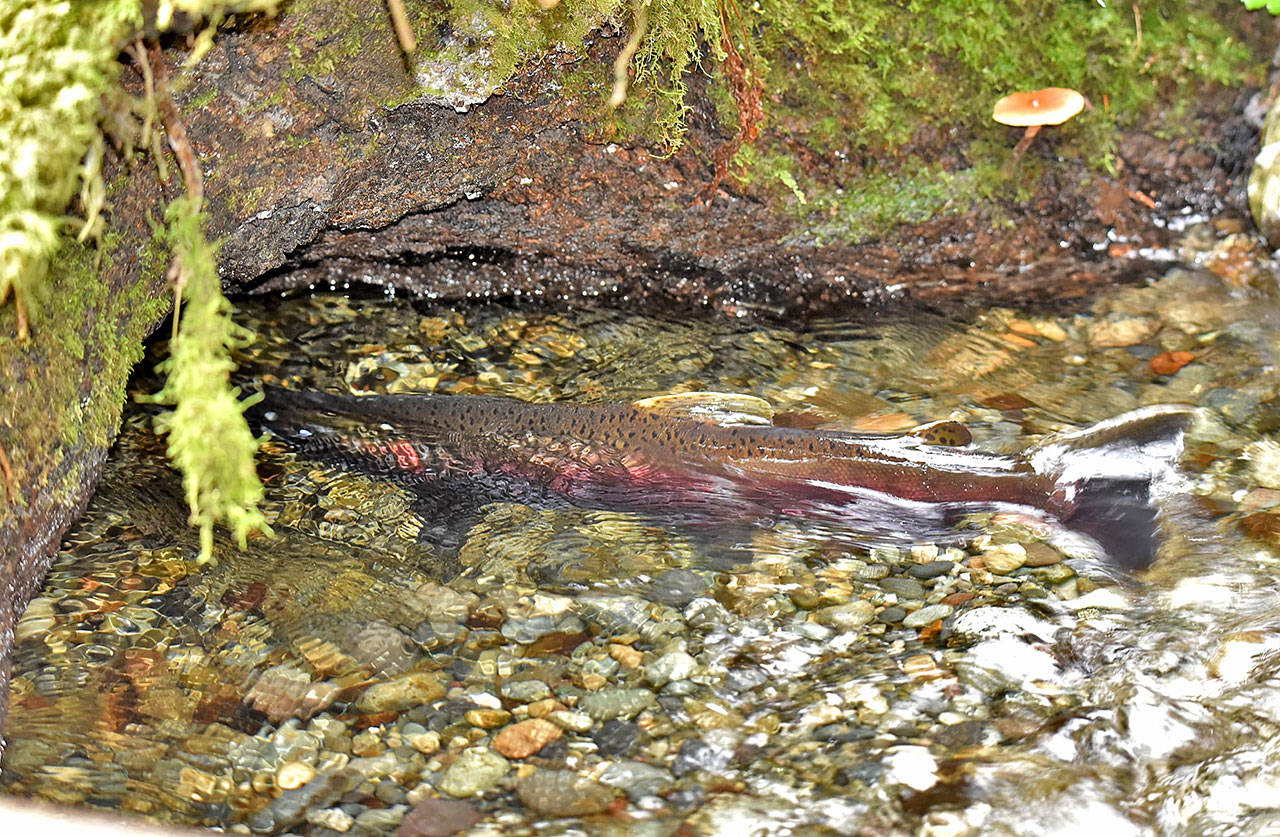This year, we had an uncommonly beautiful autumn on Puget Sound due to a wet summer and a delay of heavy, windy rain to shake the leaves off the trees. But those same conditions may have also pushed back the salmon spawning season on Vashon-Maury Island’s creeks.
Autumn rains trigger a part of an intricate process of salmon migration and reproduction, which is connected to the food web and life cycles of our most iconic species in the Pacific Northwest.
Salmon need full, flowing creeks in order to reach their spawning spots. If the autumn rain doesn’t arrive at the same time as the salmon, migration stalls and they become increasingly vulnerable to predators.
According to Kelly Keenan, who organizes the Vashon Nature Center’s Salmonwatchers, the first salmon seen on Vashon this year was a Chum carcass spotted on Oct. 28. Typically, Coho salmon appear earlier than that. In 2014 and 2015, Salmonwatchers recorded the first Coho on Sept. 15. This year, the Salmonwatchers first reported three live Coho in Shinglemill Creek on Nov. 12, once heavy rains returned following an early autumn dry spell.
Photographer Jim Diers was able to get pictures of the spawning Coho and was inspired to write on the Vashon Nature Center’s Facebook page: “I thought about the hundreds of miles they had traveled in the open ocean, all of the predators they had evaded and the obstacles they had to overcome as they swam upstream on empty stomachs. In only a matter of days, they will die. Then, I spotted some fry just a few feet away. Life goes on!”
Most of the salmon spotted on Vashon are in Judd and Shinglemill creeks. In 2018, Shinglemill had 123 Chum and 20 Coho. Judd Creek had 75 Coho and 50 Chum. Salmonwatchers also count redds, which are basically salmon nests — the depressions a female salmon creates in the creek bottom to lay her eggs. Last year, volunteers counted 34 redds in Vashon’s creeks.
The Washington Department of Fish and Wildlife forecasts a low to average year for most salmon species in 2019. However, they expect Coho salmon may be up approximately 15% from the 10-year average.
Data collected by Vashon’s Salmonwatchers can help scientists determine how fluctuations in our local salmon population compare to the overall population in Puget Sound. Going forward, it should help the Vashon-Maury Island Land Trust measure the success of several conservation and restoration efforts currently underway around Judd and Shinglemill creeks.
VNC is also participating in salmon DNA studies being conducted by the Cedar Coast Field Station in British Columbia by clipping the fins of dead salmon and contributing them to a database. Researchers are using his information to establish how various salmon are related to one another and to the wild and hatchery populations throughout the Salish Sea.
There are more than 40 trained Salmonwatchers on Vashon. This year VNC put their training program online at vashonnaturecenter.org/salmonwatchers so unofficial salmon enthusiasts can learn more about the fish in our local creeks.
Thursday, Dec. 12 and Friday, Dec. 13
Forage Fish Surveys
Join Vashon Nature Center scientists on the beach to survey for forage fish eggs on Thursday from 7:30 to 10 p.m., then process the samples at Vashon Center for the Arts on Friday from 9:30 a.m. to 12 p.m. Must be able to walk up to 1/2 mile on the beach. For more info or to sign up, email mariametler.vnc@gmail.com.
Saturday, Dec. 14
Vashon Audubon Birding Field Trip
Free Drop-in Birding — no experience necessary — from 9 a.m. to 11 a.m. Meet at Ober Park’s Park & Ride for carpooling to the site. Come meet the birds who live on the island this season. Bring binoculars and scopes if you have them and wear walking shoes or boots. Children must be accompanied by an adult.
Sunday, Jan. 5
Audubon Christmas Bird Count
Add to more than a century of community science data by signing up to count birds with experienced field teams or in your own backyard. Contact Ezra Parker for information on how to participate by emailing ezra@cfgrok.com.


